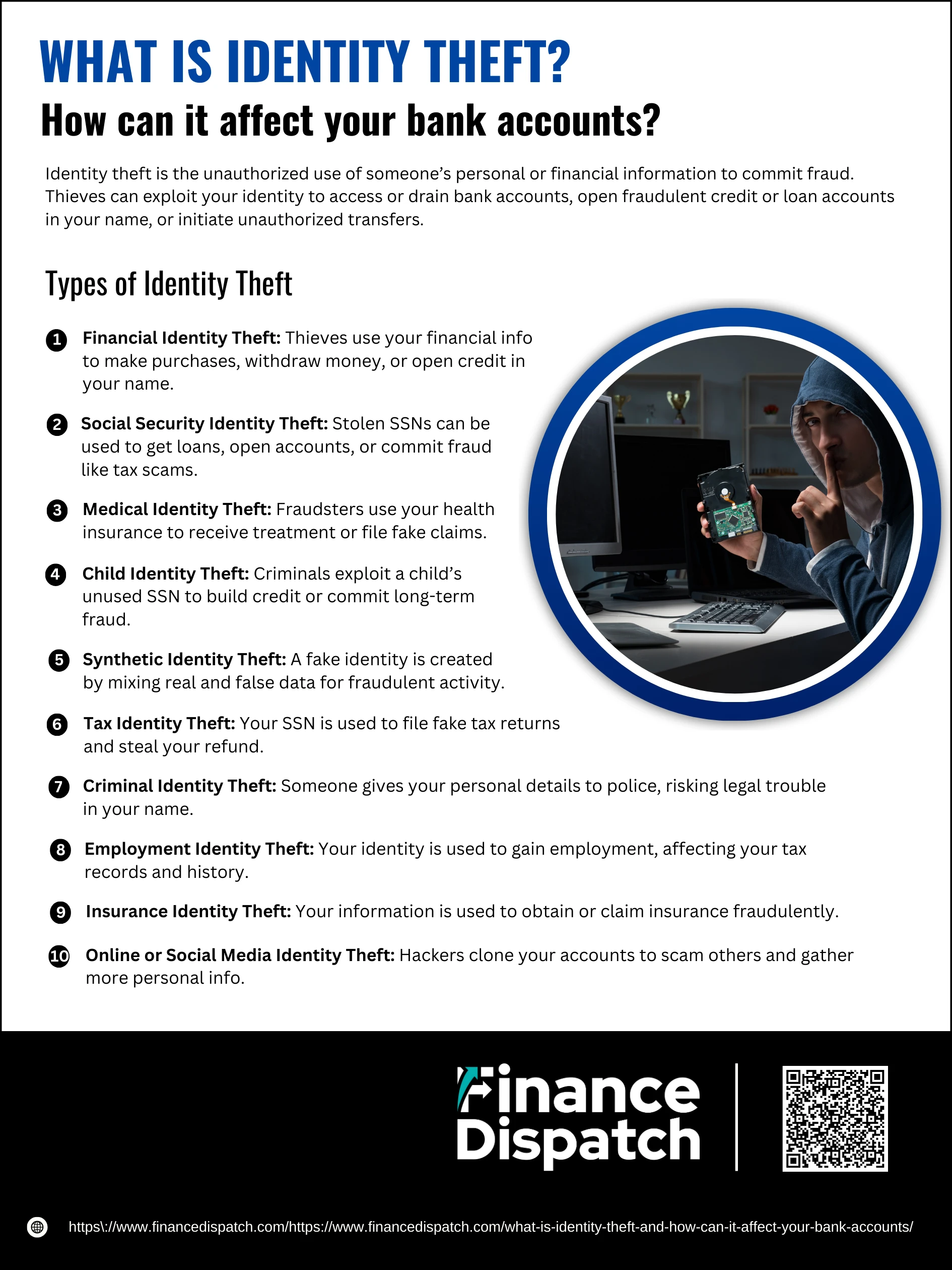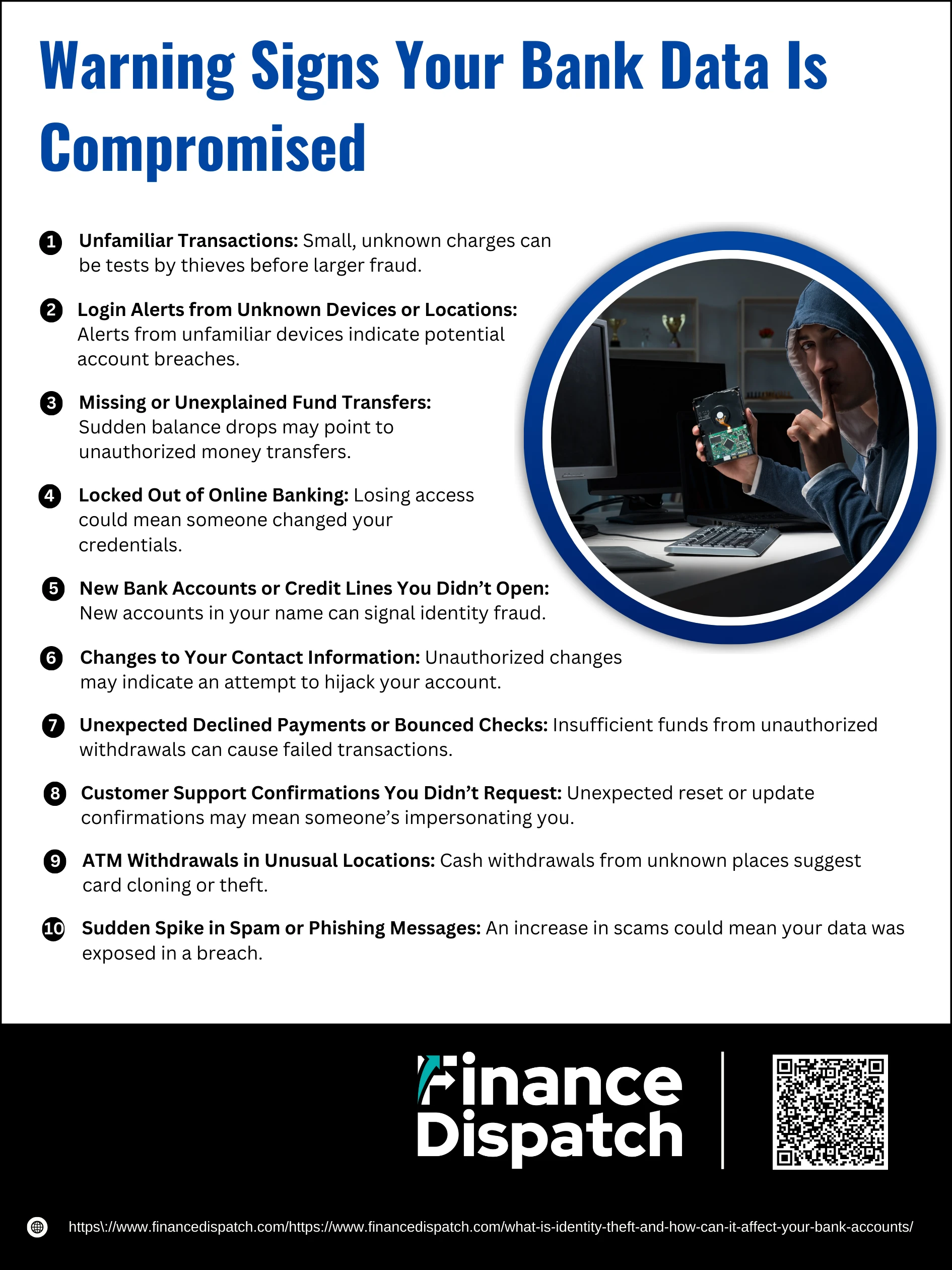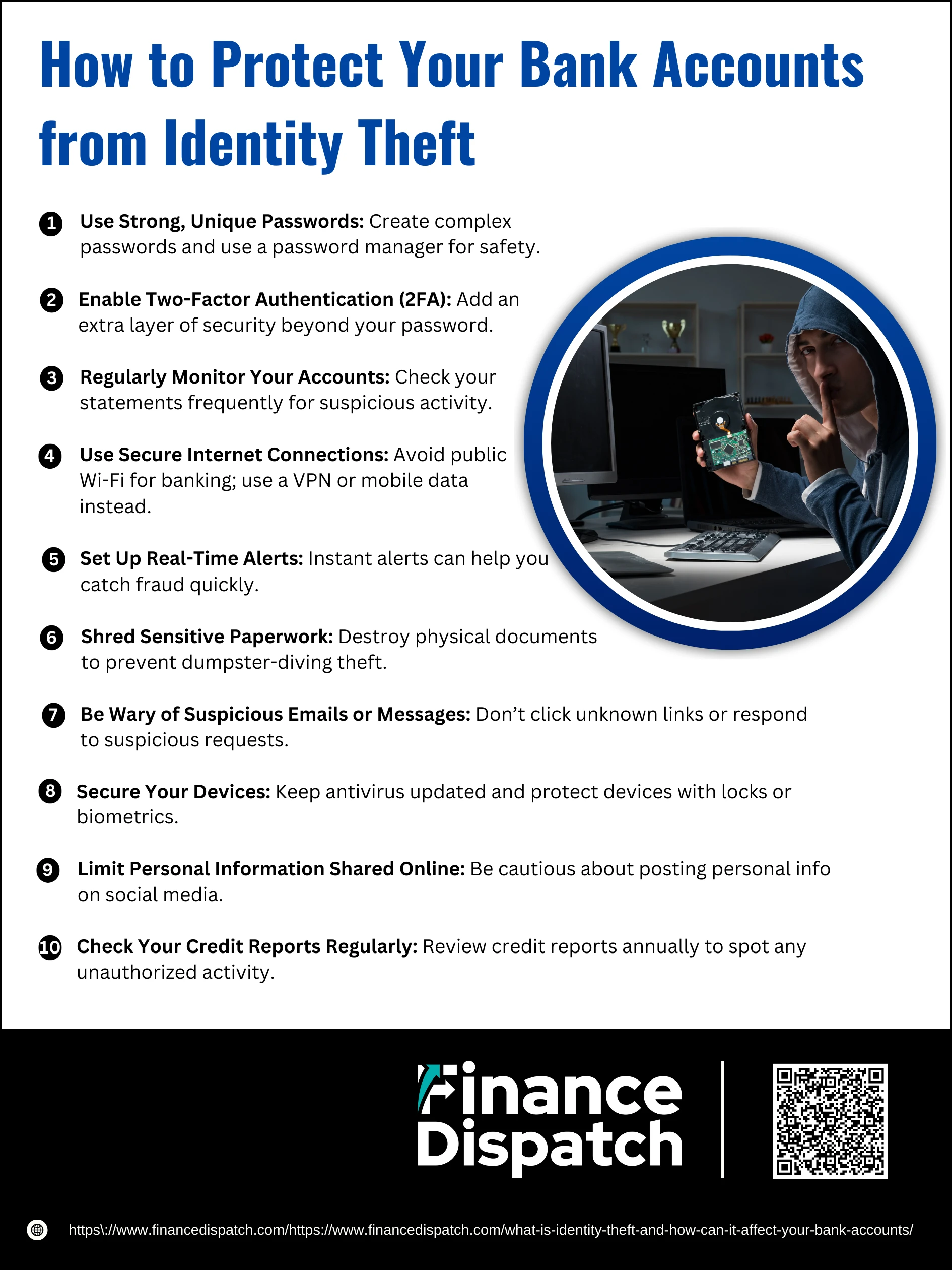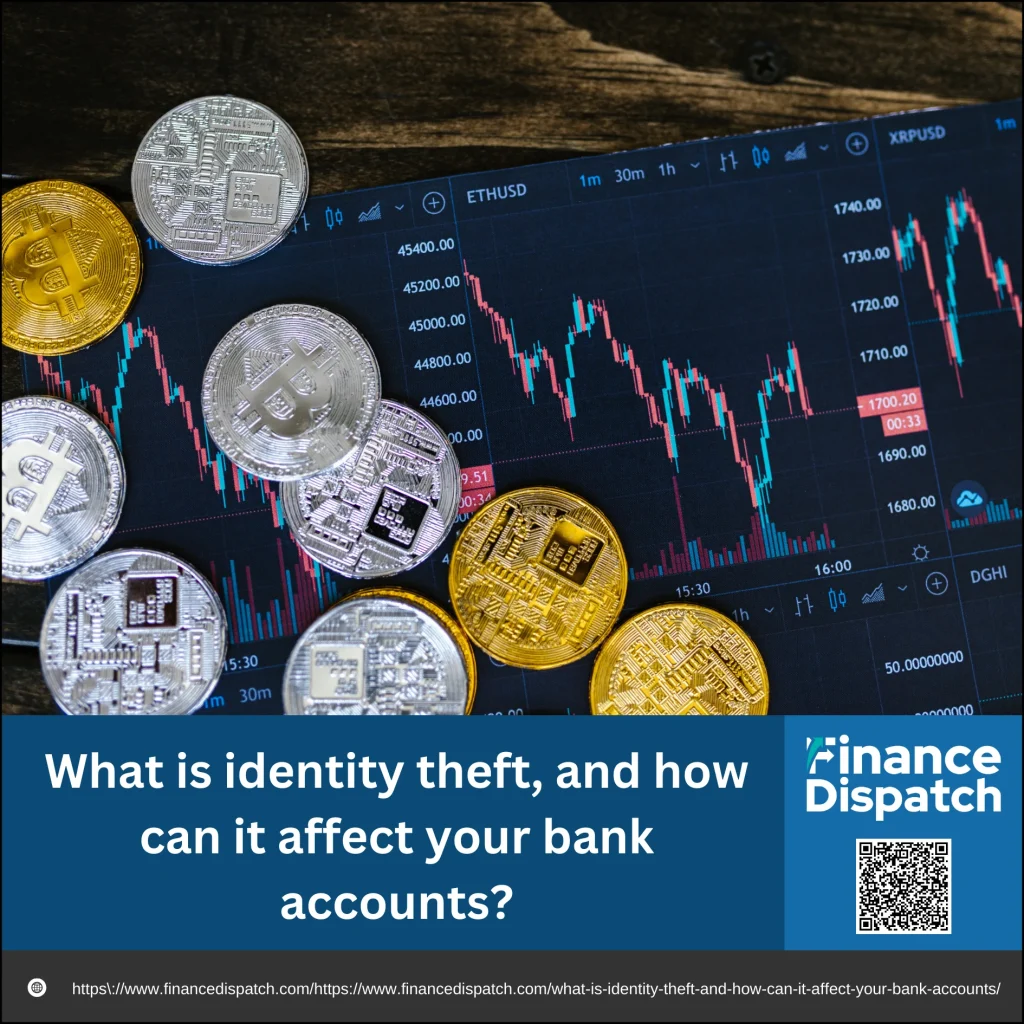In today’s digital-first world, where banking, shopping, and communication happen with a few clicks, your personal information is more valuable—and more vulnerable—than ever. Identity theft, the crime of using someone else’s personal data without permission, has become a growing concern for individuals and institutions alike. From your name and Social Security number to your bank login credentials, any piece of stolen information can be used to wreak financial havoc. One of the most alarming consequences of identity theft is the impact it can have on your bank accounts—leading to unauthorized transactions, drained savings, and even new fraudulent accounts opened in your name. Understanding what identity theft is, how it happens, and how it targets your banking information is essential to safeguarding your financial well-being.
What Is Identity Theft?
Identity theft is a serious crime in which someone steals and uses your personal information—such as your name, Social Security number, bank account details, or credit card number—without your knowledge or consent. The goal is typically to commit fraud, whether that means making unauthorized purchases, opening new lines of credit, draining bank accounts, or even posing as you in legal or medical situations. Unlike a simple theft of a wallet or phone, identity theft can be invisible at first, often going unnoticed until significant financial or reputational damage has been done. Because your identity is the key to your financial life, when it’s stolen, the consequences can be both immediate and long-lasting.
 Types of Identity Theft
Types of Identity Theft
Identity theft isn’t a one-size-fits-all crime. Criminals can target different aspects of your personal information depending on what they want to achieve—whether it’s to steal money, receive medical services, avoid legal consequences, or build an entirely fake identity. Understanding the different types of identity theft is the first step in recognizing the risks and protecting yourself against this increasingly sophisticated crime.
1. Financial Identity Theft
This is the most widespread form of identity theft. It occurs when someone uses your financial information—like your bank account number, credit card details, or personal identifiers—to make purchases, withdraw money, or apply for credit in your name. Victims often face damaged credit scores and unrecognized debts.
2. Social Security Identity Theft
Your Social Security number is a goldmine for thieves. Once stolen, it can be used to secure loans, open bank accounts, obtain government benefits, or even commit tax fraud. The repercussions can include denied benefits, legal complications, and long-term financial damage.
3. Medical Identity Theft
In this form of identity theft, a criminal uses your personal information or health insurance details to access medical services, prescriptions, or insurance claims. This not only leads to medical bills you’re unaware of but can also compromise your actual medical records, putting your health at risk.
4. Child Identity Theft
Children’s identities are attractive targets because they typically have clean credit histories and are less likely to be monitored. A thief may use a child’s Social Security number to open credit accounts, apply for government benefits, or even buy a house—often going undetected for years until the child becomes an adult.
5. Synthetic Identity Theft
Here, a criminal fabricates a new identity by combining real and fake information—such as using a real Social Security number with a fake name and birthdate. This “synthetic” identity is then used to build credit and commit fraud, making it hard to trace and even harder to clean up.
6. Tax Identity Theft
In this case, someone uses your Social Security number to file a tax return and claim your refund before you do. Victims often don’t discover the fraud until they try to file their legitimate tax return and it’s rejected by the IRS.
7. Criminal Identity Theft
A fraudster caught committing a crime might give law enforcement your name and personal details instead of their own. This can result in arrest warrants, legal issues, or even a criminal record being wrongfully attached to your name.
8. Employment Identity Theft
This happens when someone uses your identity to get a job. The employer unknowingly files tax documents under your name, potentially leading to IRS audits, unexpected tax liabilities, or questions about your employment history.
9. Insurance Identity Theft
Thieves may use your personal information to obtain insurance policies—auto, health, or life—and file fraudulent claims. This can increase your premiums, cancel your policies, or complicate legitimate claims you try to make in the future.
10. Online or Social Media Identity Theft
Cybercriminals may hack or clone your online accounts—especially on social media—to impersonate you, scam your friends, spread misinformation, or collect even more sensitive data. This type of identity theft can damage your reputation and personal relationships.
How Identity Theft Happens
Identity theft doesn’t always start with a stolen wallet or a hacked email. In today’s digital age, criminals use a wide range of techniques—from sophisticated cyberattacks to simple human tricks—to get access to your personal information. Once they have it, they can cause financial chaos, impersonate you, or even commit crimes in your name. Knowing how identity theft happens can help you take smarter steps to prevent it.
1. Phishing Scams
Fraudsters send fake emails or messages pretending to be from trusted organizations, tricking you into revealing login credentials, banking details, or Social Security numbers.
2. Smishing and Vishing
These are variations of phishing using text messages (smishing) or phone calls (vishing) to manipulate you into giving away sensitive information.
3. Data Breaches
Hackers break into company databases and steal personal records, including names, passwords, credit card numbers, and more—often on a massive scale.
4. Skimming and Card Cloning
Devices attached to ATMs or point-of-sale terminals capture card details and PINs, allowing criminals to clone your debit or credit card.
5. Malware and Spyware
Malicious software installed on your devices (often unknowingly) records keystrokes or transmits files to identity thieves.
6. Public Wi-Fi Attacks
Unsecured networks make it easy for hackers to intercept data you send while browsing or logging into bank accounts or email.
7. Dumpster Diving
Thieves physically search through your trash to find discarded bills, pre-approved credit offers, or personal documents.
8. Social Media Oversharing
Posting personal details like your birthday, address, or even your pet’s name (often used in security questions) can give criminals the clues they need.
9. Mail Theft and Change of Address Fraud
Criminals steal physical mail or reroute it by submitting a change of address request, gaining access to bank statements and credit offers.
10. Fake Websites and Spoofed Links
Imitation websites or misleading ads trick users into entering login information or payment details.
How Identity Theft Affects Your Bank Accounts
When your identity is stolen, one of the first and most dangerous targets is your bank account. Criminals can use your personal data—like account numbers, debit card info, or login credentials—to drain funds, make unauthorized purchases, or even open new accounts under your name. The damage can range from temporary inconvenience to long-term financial and credit problems. Below is a table outlining the common ways identity theft affects bank accounts and the consequences that follow:
| Method of Identity Theft | What Criminals Do | Impact on Your Bank Account |
| Stolen debit/credit card data | Use card numbers to make purchases or withdraw cash | Unauthorized charges, overdrafts, possible loss of funds |
| Phishing or hacking | Access online banking using login credentials | Account takeover, lockouts, stolen funds |
| Synthetic identity creation | Open new accounts using real + fake information | You’re held responsible for debt you didn’t incur |
| Check fraud | Forge or steal checks and cash them | Funds removed fraudulently, frozen accounts |
| Account takeover | Change passwords, email, or contact details | Loss of access, unauthorized wire transfers |
| Change of address fraud | Reroute your mail to intercept bank statements/cards | Missed fraud alerts, delayed discovery of identity theft |
| ATM skimming | Clone your card using hidden devices at ATMs or terminals | Unauthorized ATM withdrawals, compromised PINs |
| Fake customer service scams | Pretend to be bank reps and collect personal info | Access to account or card details, potential for fraud escalation |
| Use of stolen Social Security number | Apply for loans or new accounts linked to your bank | Affects your credit and increases scrutiny on your real account |
 Warning Signs Your Bank Data Is Compromised
Warning Signs Your Bank Data Is Compromised
Identity theft is often a silent crime—it doesn’t always hit you with an obvious alarm. Instead, it sneaks in through the cracks of your financial life, showing subtle signs before the real damage surfaces. If your bank data is compromised, you might not realize it until unauthorized withdrawals, declined payments, or strange alerts start showing up. That’s why it’s crucial to recognize the early warning signs. Catching these red flags early can mean the difference between a quick fix and months—or even years—of recovery.
10 Warning Signs Your Bank Data May Be Compromised
1. Unfamiliar Transactions
If you notice charges or purchases that you don’t remember making—no matter how small—it could indicate that someone is testing your account. Criminals often start with minor purchases to see if the account is active before launching larger attacks.
2. Login Alerts from Unknown Devices or Locations
Many banks send emails or SMS alerts when someone logs into your account from a new device or geographic location. If you receive such alerts without logging in yourself, someone else may be trying—or has succeeded—in accessing your account.
3. Missing or Unexplained Fund Transfers
Sudden decreases in your bank balance without explanation can be a sign that money is being transferred out. These could be small amounts over time or large sums in a single unauthorized transaction.
4. Locked Out of Online Banking
If you can’t log into your bank account using your normal credentials, it’s possible a criminal has changed your password or locked you out by guessing the wrong login too many times.
5. New Bank Accounts or Credit Lines You Didn’t Open
Sometimes identity thieves open additional accounts or lines of credit under your name. You may find these when checking your online banking dashboard or reviewing your credit report.
6. Changes to Your Contact Information
If your bank alerts you that your registered email, phone number, or mailing address has been changed—and you didn’t authorize it—it’s a sign that someone might be trying to intercept communications or gain control of your account.
7. Unexpected Declined Payments or Bounced Checks
Transactions that fail due to insufficient funds—especially when you know your balance is adequate—could be a sign that money has been drained or transferred without your knowledge.
8. Customer Support Confirmations You Didn’t Request
Emails or text messages confirming a password reset, PIN change, or account update that you didn’t initiate may indicate someone is trying to gain access through customer service channels.
9. ATM Withdrawals in Unusual Locations
Unauthorized cash withdrawals, particularly in cities or countries where you haven’t traveled, may mean your debit card or its information has been cloned through ATM skimming.
10. Sudden Spike in Spam or Phishing Messages
A sudden increase in scam emails, texts, or calls targeting your financial information may suggest your data has been exposed in a breach or leak, making you a potential target for further fraud.
 How to Protect Your Bank Accounts from Identity Theft
How to Protect Your Bank Accounts from Identity Theft
In a world where digital banking is the norm and financial data moves faster than ever, protecting your bank accounts has become a personal responsibility. Identity thieves are constantly developing new ways to steal information—from phishing emails and malware to card skimming and social engineering. Once they have access, they can empty your savings, take out loans in your name, or damage your credit before you even realize something is wrong. But the good news is that you can take practical, effective steps to defend yourself. Here are the top ways to keep your bank accounts safe from identity theft:
1. Use Strong, Unique Passwords
Avoid simple passwords like “123456” or your birthdate. Instead, use long, random combinations of letters, numbers, and symbols. Better yet, use a password manager to generate and store complex passwords securely—one unique password for each financial account.
2. Enable Two-Factor Authentication (2FA)
Whenever your bank or financial app offers two-factor authentication, turn it on. This feature requires a second step (like entering a code sent to your phone) before allowing access, making it much harder for hackers to get in even if they have your password.
3. Regularly Monitor Your Accounts
Get into the habit of checking your bank and credit card statements weekly. If you spot even small unauthorized charges, report them immediately—they may be “test” charges by scammers before larger fraud.
4. Use Secure Internet Connections
Never log into your bank account using public Wi-Fi at coffee shops, airports, or hotels. If you must access financial services while away from home, use a Virtual Private Network (VPN) or your phone’s mobile data instead.
5. Set Up Real-Time Alerts
Most banks let you enable text or email alerts for transactions, withdrawals, login attempts, or password changes. These alerts help you spot unauthorized activity right away so you can take action quickly.
6. Shred Sensitive Paperwork
Physical theft still happens. Don’t toss bank statements, old checks, or credit card offers into the trash whole. Shred them first to prevent dumpster-divers from harvesting your data.
7. Be Wary of Suspicious Emails or Messages
Phishing attempts often mimic real bank emails. They may ask you to click a link or call a fake support number. Always verify the sender, never click suspicious links, and contact your bank directly if you’re unsure.
8. Secure Your Devices
Install reputable antivirus software, keep your apps and system up to date, and avoid downloading from unknown sources. Also, make sure your phone, tablet, or laptop is protected with a passcode, fingerprint, or face recognition.
9. Limit Personal Information Shared Online
Criminals can piece together details about your life from what you post—like your pet’s name or favorite school—often used as password hints. Keep your profiles private and think twice before sharing personal info.
10. Check Your Credit Reports Regularly
At least once a year, request a free copy of your credit report from each of the three major credit bureaus (Experian, Equifax, and TransUnion) via AnnualCreditReport.com. Look for unfamiliar accounts, names, or addresses, which could signal identity theft in progress.
Conclusion
Identity theft is a growing threat in today’s digital world, and your bank account is one of the primary targets. From unauthorized transactions to complete account takeovers, the financial and emotional toll can be devastating. However, staying informed and proactive can make all the difference. By understanding how identity theft happens, recognizing the warning signs early, and implementing strong security practices—like using two-factor authentication, monitoring your accounts, and securing your personal information—you can significantly reduce your risk. Protecting your bank account isn’t just about safeguarding your money; it’s about preserving your peace of mind and long-term financial stability.



